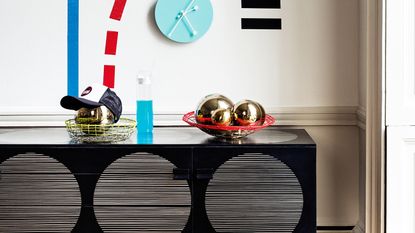Health specialists explain why we should bring circular shapes into our interiors
Circular patterns are soothing, stimulating, and indisputably stylish – experts reveal how they could re-shape your home


We all have specific colors, patterns, and textures that spark joy – but how often do we think about the shapes that make us happy? According to psychological research*, one shape, in particular, has the ability to positively improve our emotions and boost our wellbeing – and health specialists are urging us to inject the shape throughout our home decor.
Studies suggest that we receive round shapes, particularly circles, more positively than alternate shapes, and this stimulating and intriguing shape may be the secret to a therapeutic and happy home. Here, health specialists reveal why we should fill our homes with this scientifically acclaimed shape.
Why should we bring circular shapes into our interiors?

'Geometric shapes are the simplest and most common; squares, circles, triangles and their derivatives such as rectangles, ovals, and polygons. The familiarity of these shapes makes them easy to use throughout the home,' shares the experts at Delamere.
But before we invest in new circular furnishings, they reveal the science behind the joy of circles and how it contributes to a therapeutic remedial space.
Circular shapes offer reassurance

'Circles and ovals are instantly recognizable, making us feel a sense of security and similarity. Simplistic shapes like these provide a feeling of stability and assurance. People commonly associate circles with the shape of the earth, sun, and moon, thus the reasoning behind the feeling of trust and authority,' the experts share.
'Circular shapes are considered to be a much friendlier shape than the others, as they feel softer and milder, providing a feeling of unity and protection. The rounded shape tends to invite individuals into their' completeness.'
Circular shapes are less threatening

Choosing round furniture can make a room feel more welcoming and approachable, as our brains are programmed to believe that 'sharp corners are harmful.' However, the benefits don't end there, as the experts explain:
'Humans are more drawn to curvilinear shapes as opposed to angular shapes, something that Psychologist John N. Bassili discovered. The research found that the circular shape was the abstract symbol for happiness, while the triangular shape represented anger.'
'Rounded furniture can add a friendly and approachable vibe to the room, as our brains are conditioned to think sharp corners are harmful,' they add.
Circular shapes are undeniably stylish

While we revel in the circle's health benefits, we can't help but celebrate the circle's ultra-stylish qualities. In her discussion of a circular rug, Residential Design Manager at Brintons, Jodie Hatton, praises the shape for its ability to 'create a cohesive look within a room.'
'The circular shape can echo other elements of circular shapes such as the architecture of the space, room accessories, lighting fixtures, and furniture shapes without looking overdone. This will pull the overall look of the room together and underscore the room's curves, turning them into a more notable design feature,' she says.

See: How to make your hallway feel happy by interiors expert Michelle Ogundehin
We're dedicating this week to filling our homes with the sunniest shape of them all – we've got all the approval we could ever need.
*On Shape and the Computability of Emotions, The Pennsylvania State University
Be The First To Know
The Livingetc newsletter is your shortcut to the now and the next in home design. Subscribe today to receive a stunning free 200-page book of the best homes from around the world.
Megan is the News and Trends Editor at Homes & Gardens. She first joined Future Plc as a News Writer across their interiors titles, including Livingetc and Real Homes. As the News Editor, she often focuses on emerging microtrends, well-being stories, and celebrity-focused pieces.
Before joining Future, Megan worked as a News Explainer at The Telegraph, following her MA in International Journalism at the University of Leeds. During her BA in English Literature and Creative Writing, she gained writing experience in the US whilst studying in New York. Megan also focused on travel writing during her time living in Paris, where she produced content for a French travel site.
-
 The 12 Best Table Lamps for Reading —I'm a Certified Bookworm (and Shopping Expert)
The 12 Best Table Lamps for Reading —I'm a Certified Bookworm (and Shopping Expert)When it comes to table lamps for reading, I don't mess around. If you're the same, this edit is for YOU (and your books, or course — and good recommendations?)
By Brigid Kennedy Published
-
 "It's Scandi Meets Californian-Cool" — The New Anthro Collab With Katie Hodges Hits Just the Right Style Note
"It's Scandi Meets Californian-Cool" — The New Anthro Collab With Katie Hodges Hits Just the Right Style NoteThe LA-based interior designer merges coastal cool with Scandinavian simplicity for a delightfully lived-in collection of elevated home furnishings
By Julia Demer Published

